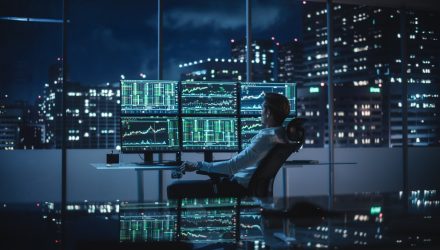Capturing the night effect can enhance client portfolios by lifting risk-adjusted returns and offering non-correlated exposure to other asset classes.
Many advisors are still unaware of the night effect despite the market anomaly having been studied academically for over two decades. Just 53% of advisors recently polled said they were aware of the difference between overnight and day session returns, according to “How the Night Effect Can Benefit Your Portfolio.” (Date: February 21, 2023. Sample size: 222 respondents, 39.6% RIAs)
Thus, it seems fair to assume the number of end clients familiar with the night effect is even lower. Advisors can use these tips to help guide conversations with end clients.
What Is the Night Effect, and How Can Investors Access It?
The night effect is a market anomaly in which overnight markets have historically outperformed the daytime trading session on a risk-adjusted basis. The overnight trading session has delivered much of U.S. large- and small-cap equities’ returns with much lower volatility than the day session over the past 20 years.
The night effect became accessible to advisors in an ETF wrapper for the first time with last year’s launch of the NightShares 500 ETF (NSPY), the NightShares 2000 ETF (NIWM), and the NightShares 500 1x/1.5x ETF (NSPL).
NSPY offers exposure to the night performance of 500 large-cap U.S. companies (essentially the night session of the S&P 500), while the NIWM provides exposure to the night performance of 2,000 small-cap U.S. companies (the night session of the Russell 2000).
NSPL offers exposure to both night and day sessions but tilts toward the night. The fund provides investment results, before fees and expenses, that correspond to 100% of the performance of a portfolio of 500 large-cap U.S. companies during the day and 150% of the portfolio performance at night.
How Has the Night Performed in the Past?
The power of the night effect was highlighted in last year’s performance. If an investor were to simply buy the SPDR S&P 500 ETF Trust (SPY) at close and sell the open every trading day, they would have lost 13.34%, outperforming buy and hold by nearly 5%. In small caps, buying the close and selling the open would have outperformed the buy-and-hold session of the iShares Russell 2000 ETF (IWM) by 12%. Since buying and selling a basket of securities at market close and open every day isn’t realistic, this is where NSPY and NIWM come in handy.
Is Investing in the Night Risky?
The night effect has outperformed on a risk-adjusted basis over the past 20 years. The historically lower volatility of the overnight session may lead to better up/down capture ratios, allowing investors to maintain their target equity exposure more comfortably through periods of market turbulence.
Stepping through the Sharpe ratios for various trading sessions (day, night, and hold) is a good way to explain the night effect to clients.
Looking at the past 20-year record (2003 through 2022), the SPDR S&P 500 ETF Trust (SPY) Sharpe ratio is 0.54 for holding the fund. Meanwhile, during the same period, the night session Sharpe ratio is 0.62, while the day session Sharpe ratio is just 0.16.
The power of the night effect is even more pronounced among small caps during the same 20-year period. The iShares Russell 2000 ETF (IWM) Sharpe ratio is 0.46 for holding the ETF, the night session Sharpe ratio is 0.90, and the day session Sharpe ratio is -0.08.
This last point is particularly notable: the day session Sharpe ratio is negative because over 100% of small caps’ returns over a 20-year period have come at night.
For more news, information, and analysis, visit the Night Effect Channel.

